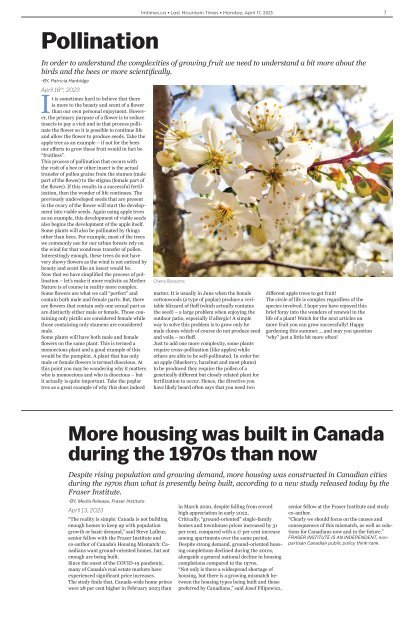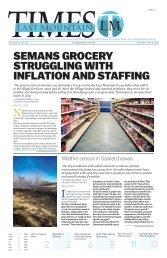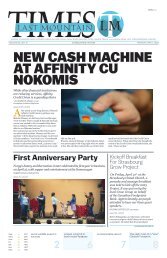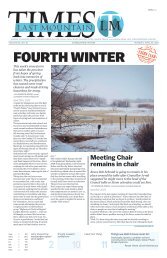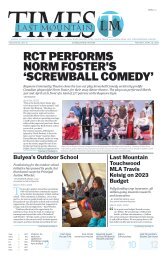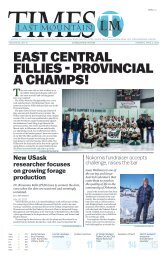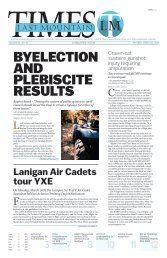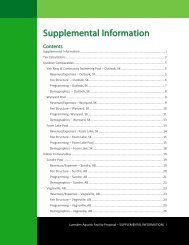LMT_Apr_17_2022_Vol_116_issue_17 v2
You also want an ePaper? Increase the reach of your titles
YUMPU automatically turns print PDFs into web optimized ePapers that Google loves.
lmtimes.ca • Last Mountain Times • Monday, <strong>Apr</strong>il <strong>17</strong>, 2023<br />
7<br />
Pollination<br />
In order to understand the complexities of growing fruit we need to understand a bit more about the<br />
birds and the bees or more scientifically.<br />
-BY, Patricia Hanbidge<br />
<strong>Apr</strong>il 16 th , 2023<br />
It is sometimes hard to believe that there<br />
is more to the beauty and scent of a flower<br />
than our own personal enjoyment. However,<br />
the primary purpose of a flower is to seduce<br />
insects to pay a visit and in that process pollinate<br />
the flower so it is possible to continue life<br />
and allow the flower to produce seeds. Take the<br />
apple tree as an example – if not for the bees<br />
our efforts to grow these fruit would in fact be<br />
“fruitless”.<br />
This process of pollination that occurs with<br />
the visit of a bee or other insect is the actual<br />
transfer of pollen grains from the stamen (male<br />
part of the flower) to the stigma (female part of<br />
the flower). If this results in a successful fertilization,<br />
then the wonder of life continues. The<br />
previously undeveloped seeds that are present<br />
in the ovary of the flower will start the development<br />
into viable seeds. Again using apple trees<br />
as an example, this development of viable seeds<br />
also begins the development of the apple itself.<br />
Some plants will also be pollinated by things<br />
other than bees. For example, most of the trees<br />
we commonly use for our urban forests rely on<br />
the wind for that wondrous transfer of pollen.<br />
Interestingly enough, these trees do not have<br />
very showy flowers as the wind is not enticed by<br />
beauty and scent like an insect would be.<br />
Now that we have simplified the process of pollination<br />
– let’s make it more realistic as Mother<br />
Nature is of course in reality more complex.<br />
Some flowers are what we call “perfect” and<br />
contain both male and female parts. But, there<br />
are flowers that contain only one sexual part so<br />
are distinctly either male or female. Those containing<br />
only pistils are considered female while<br />
those containing only stamens are considered<br />
male.<br />
Some plants will have both male and female<br />
flowers on the same plant. This is termed a<br />
monoecious plant and a good example of this<br />
would be the pumpkin. A plant that has only<br />
male or female flowers is termed dioecious. At<br />
this point you may be wondering why it matters<br />
who is monoecious and who is dioecious – but<br />
it actually is quite important. Take the poplar<br />
tree as a great example of why this does indeed<br />
Cherry Blossoms<br />
matter. It is usually in June when the female<br />
cottonwoods (a type of poplar) produce a veritable<br />
blizzard of fluff (which actually contains<br />
the seed) – a large problem when enjoying the<br />
outdoor patio, especially if allergic! A simple<br />
way to solve this problem is to grow only he<br />
male clones which of course do not produce seed<br />
and voila – no fluff.<br />
Just to add one more complexity, some plants<br />
require cross-pollination (like apples) while<br />
others are able to be self-pollinated. In order for<br />
an apple (blueberry, hazelnut and most plums)<br />
to be produced they require the pollen of a<br />
genetically different but closely related plant for<br />
fertilization to occur. Hence, the directive you<br />
have likely heard often says that you need two<br />
different apple trees to get fruit!<br />
The circle of life is complex regardless of the<br />
species involved. I hope you have enjoyed this<br />
brief foray into the wonders of renewal in the<br />
life of a plant! Watch for the next articles on<br />
more fruit you can grow successfully! Happy<br />
gardening this summer…..and may you question<br />
“why” just a little bit more often!<br />
More housing was built in Canada<br />
during the 1970s than now<br />
Despite rising population and growing demand, more housing was constructed in Canadian cities<br />
during the 1970s than what is presently being built, according to a new study released today by the<br />
Fraser Institute.<br />
-BY, Media Release, Fraser Institute<br />
<strong>Apr</strong>il 13, 2023<br />
“The reality is simple: Canada is not building<br />
enough homes to keep up with population<br />
growth or basic demand,” said Steve Lafleur,<br />
senior fellow with the Fraser Institute and<br />
co-author of Canada’s Housing Mismatch: Canadians<br />
want ground-oriented homes, but not<br />
enough are being built.<br />
Since the onset of the COVID-19 pandemic,<br />
many of Canada’s real estate markets have<br />
experienced significant price increases.<br />
The study finds that, Canada-wide home prices<br />
were 28 per cent higher in February 2023 than<br />
in March 2020, despite falling from record<br />
high appreciation in early <strong>2022</strong>.<br />
Critically, “ground-oriented” single-family<br />
homes and townhouse prices increased by 31<br />
per cent, compared with a <strong>17</strong> per cent increase<br />
among apartments over the same period.<br />
Despite strong demand, ground-oriented housing<br />
completions declined during the 2010s,<br />
alongside a general national decline in housing<br />
completions compared to the 1970s.<br />
“Not only is there a widespread shortage of<br />
housing, but there is a growing mismatch between<br />
the housing types being built and those<br />
preferred by Canadians,” said Josef Filipowicz,<br />
senior fellow at the Fraser Institute and study<br />
co-author.<br />
“Clearly we should focus on the causes and<br />
consequences of this mismatch, as well as solutions<br />
for Canadians now and in the future.”<br />
FRASER INSTITUTE IS AN INDEPENDENT, nonpartisan<br />
Canadian public policy think-tank.


